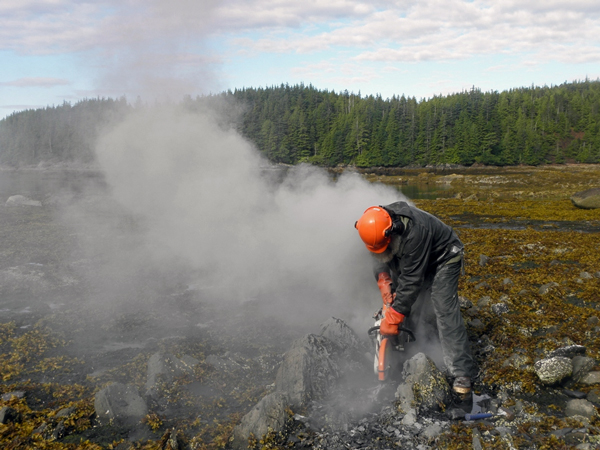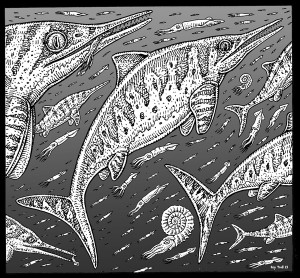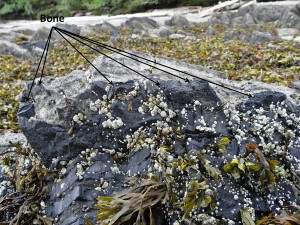
Whatever you do, don’t call them dinosaurs. If you do, a geologist will quickly correct you.
“Yep. It’s not a dinosaur. It’s a marine reptile.”

That’s U.S. Forest Service geologist Jim Baichtal. In May, he went to Gravina Island with University of Alaska Fairbanks geologists Patrick Druckenmiller and Kevin May, and Ketchikan artist Ray Troll to look for some of these Triassic-age marine reptiles. They found some, and Baichtal has gone back a couple times since then to collect the fossils, package them up and send them north for further study.
Druckenmiller says Southeast Alaska has fascinating geology, including piles of rocks from the Triassic period. They formed from sediment that originally was on the sea floor. Swimming above that sediment were marine reptiles.
“These animals were swimming around these islands way out in the Pacific Ocean, and occasionally dying, and their bones settled to the sea floor,” he said. “And over millions of years, these rocks eventually traveled northwards and become part of what’s now Southeast Alaska.”
Troll, explains further how a tropical creature ended up as a fossil in Alaska: “You have to think of the Pacific Ocean as like a conveyer belt of rock. It subducts, it actually goes under and comes back around. Southeast Alaska is just a whole big jumble of this stuff. All these terrains, is what they’re called. The geological joke is this is the Southeast Alaska is a ‘terrain-wreck.’”
Troll’s draws and paints primarily fish, dinosaurs and marine reptiles in accurate detail, but then tends to place them in unusual circumstances. He has collaborated with scientists on books, and is working on a new one about fossils along the West Coast.
Ichthyosaurs have been found on Gravina previously, and Druckenmiller says that’s partly
why they knew that the rocks on Gravina might hold more. Basically, they went in and mapped the area previously, to determine the age of the rocks. Once you have that, you know whether there’s a potential for fossils.
“What we usually find happens, you go and look in these places and basically you find nothing, but the potential is there and every so often you strike it rich and find something really cool,” he said. “That was kind of the goal of this trip. To check out areas that have never been walked before by vertebrate paleontologists, to see if we could find some vertebrate fossils.”

And they did: Ichthyosaurs, which Druckenmiller says is the reptilian version of a dolphin or whale.
“Some of those bones were large enough to be from a group of ichthyosaurs we call shastasaurus or shonisaurus,” he said. “These are the largest marine reptiles that ever lived on the planet.”
So…just how cool is this?
“This is cool,” said Baichtal. “We don’t have those great sexy dinosaurs that they have Down South. We don’t have the T-rex… but we’ve got really, really neat marine reptiles.”
Baichtal says they’re done collecting the really neat fossils for now, but there’s more out there, and he asks the public to leave fossils in place if they stumble across any. He advises that amateur fossil hunters take photos, get GPS coordinates if possible, and then contact him or another geologist with the information.
“Leave them in place and don’t try to remove them because by just chipping them out of the rock, they’ll shatter and break,” he warned. “It takes specialized tools to get them out.”
It should also be noted that vertebrate fossil remains are a protected public resource, and it’s illegal to disturb them without permits.
But the scientists and citizen-scientist Troll understand the temptation.
“It’s the mystery, it’s the hunt, it’s the quest to understand. And it’s just plain fun,” Troll said.
The bones of these really cool Southeast-Alaska-not-dinosaurs – or a really good copy of them – might come back home someday. At least, Baichtal hopes that will be the case.
“So that we can share these finds with the public and our youth, and conjure up ideas and visions of Triassic seas and the wonderment that comes along with dinosaurs Down South, but with our much, much superior Triassic marine reptiles here,” he said.




